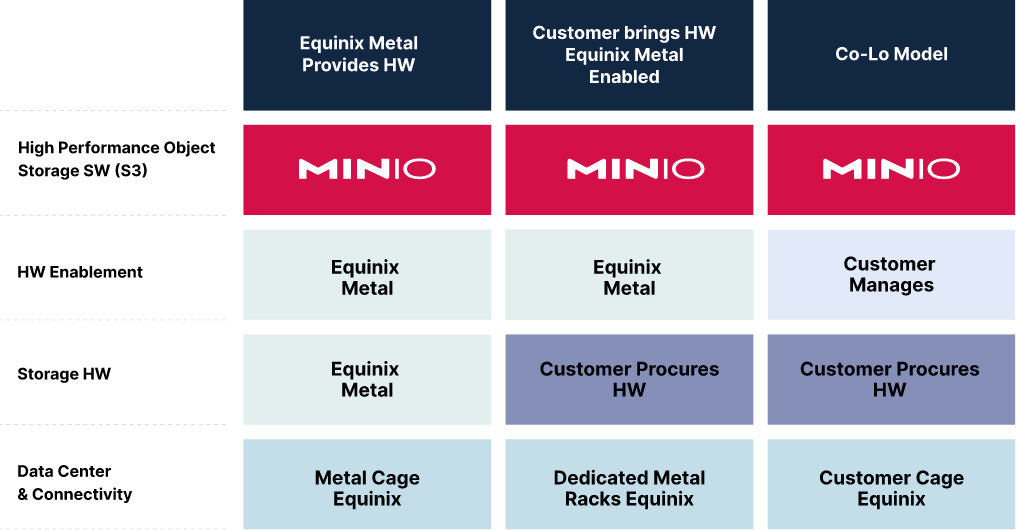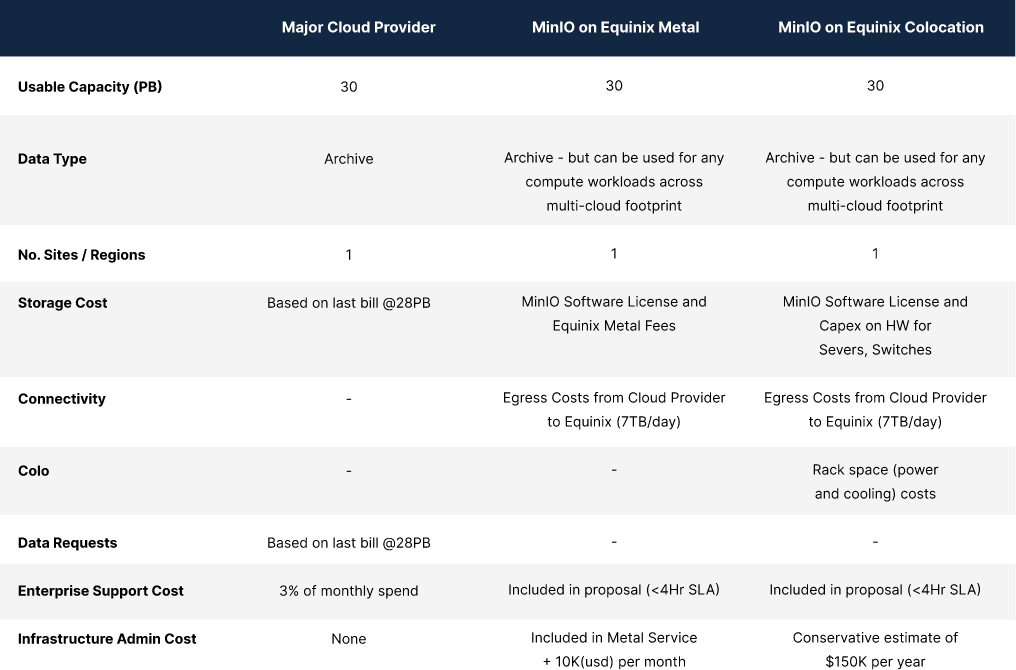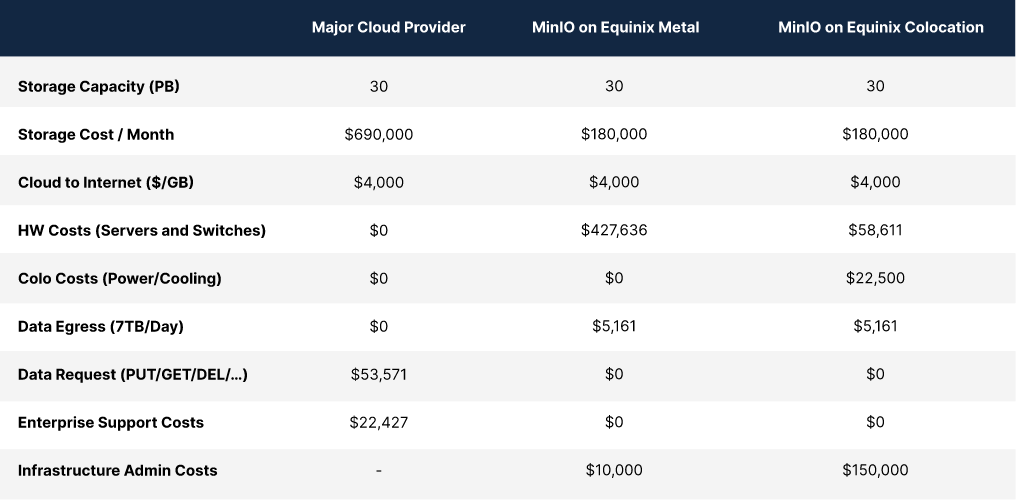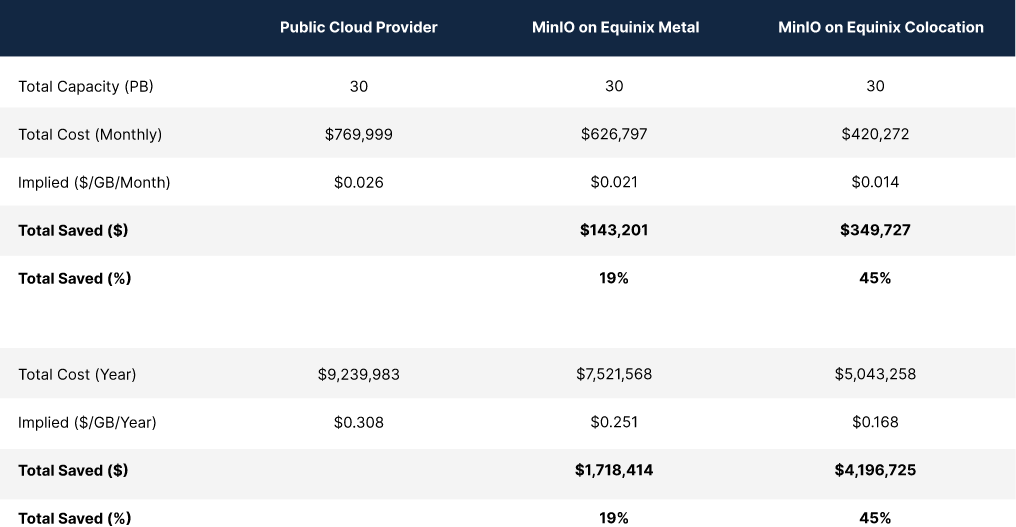Control Cloud Data Costs with MinIO on Equinix

The public cloud changed the way companies build, deploy and manage their applications - mostly for the better. As you’re getting started, the public cloud supplies the infrastructure, services, enablement and maintenance to be up and running quickly. It provides ultimate scalability, in almost unlimited fashion, up and down, to provide you with the necessary resources no matter the load on your application. You could essentially go international on fully supported infrastructure at the flip of a switch.
As time goes on, data from things like logs, customer input and application generated content can start to build up, sometimes into the petabyte and in very rare cases, the exabyte level. So, data that isn’t necessarily needed for your application’s active operation can suddenly bring unwanted surprises when your bill comes.
It’s not just that either. Nearly 60% of public cloud costs are variable. In this blog, I’ll discuss how MinIO and Equinix have partnered to help combat these costs, how it helps you sleep at night from an operational perspective and offer a real-world example of a customer’s achievement of savings.
About MinIO and Equinix
Equinix is “the world’s digital infrastructure company.” It was founded in Silicon Valley in 1998 to be a vendor neutral data center provider. They securely interconnect some of the world’s largest networks with equality and neutrality in mind. In 2020, Equinix expanded on this great offering by acquiring Packet. In doing so, Equinix was able to add on-demand server provisioning capability to its extensive data center network.
MinIO is the leading high performance object store in the market. It runs anywhere and on any hardware. Kubernetes-native and fully S3 API compatible it is the perfect pair for Equinix’s bare metal and colocation services. By combining MinIO and Equinix, developers can quickly and easily deploy S3 compatible persistent storage for any application, whether it’s hosted on Equinix, a public cloud provider, or even on-prem, allowing the flexibility for single, multi or hybrid cloud approaches.
Why you can rely on MinIO and Equinix
Flexibility
Equinix provides multiple paths towards deploying your data and high intensity workloads within their 260+ global data centers across 71 metros in 33 countries.
- Equinix Colocation - Like any colocation service, this option involves buying, building, and managing your own hardware. So, you’d deploy MinIO to your server, either in a container or on bare metal, and then deploy that server setup to one or more Equinix data centers. This route is available at any Equinix data center around the world and provides the highest total cost savings when compared to the public cloud.
- Equinix Metal - With this option, you’re taking full advantage of Equinix’s capabilities by using their bare metal server infrastructure as a service. There’s no need to supply, build, or manage your own hardware. Everything is done by Equinix’s Metal team. Equinix Metal also supports a range of deployment configurations from single-tenant, multi-user to multi-user and multi-tenant. The cost savings isn’t as high compared to the colocation approach, but it gives you a little bit of the best of both worlds. You don’t have to worry about the supply and maintenance of hardware while still saving money by offloading data and workloads that don’t need to run in the public cloud.
While these are the main two options with Equinix, they are also open to custom approaches for very large deployments.

Performance
Not every use case requires ultimate performance. Sometimes you just need a less expensive but public cloud accessible place to store large amounts of logs and historical data. However, if you currently do need performance or might in the future, rest assured, MinIO and Equinix have you covered.
With Equinix’s public cloud adjacency and interconnectivity, your data is only 1-2ms RTT from the major public clouds and <10ms RTT from your end customer’s device. MinIO will likely max out any network connectivity you can procure. It is the world's fastest object store with published GET and PUT results that exceed 325 GiB/sec and 165 GiB/sec, respectively, on 32 nodes of NVMe drives and a 100GbE network.
Saving money with the cloud you control
Pricing
One of the unique aspects of the Equinix and MinIO collaboration is the operational simplicity and financial certainty they offer with fixed annual pricing. The pricing model for Equinix and MinIO is transparent, predictable and straightforward. Equinix offers a range of pricing options from hourly on demand to custom provisioning. In the case of MinIO, the pricing model is driven by capacity - there are no charges for egress and/or API calls. Everything is included.
A real-world example
While we don’t have the ability to share the identity of this customer, the following example will give a great representation of the cost savings that can be achieved via either Equinix deployment model as this customer reviewed both options.
First, let’s look at the sizing and assumptions data used for the comparison. All of this is based on the customer’s last bill with one of the large public cloud providers. One point to note is that this comparison is not a knock on the public cloud providers. Both Equinix and MinIO partner with all the major cloud providers. This simply illustrates the modern cloud cycle of starting in the cloud and operationalize and create efficiencies with the private cloud.

When we plug in the numbers on this based on the customer’s previous bill and Equinix and MinIO’s transparent pricing (using very conservative estimates), it starts to take shape.

Finally, if we do all the math we end up with the following savings. Keep in mind, these savings are based on conservative figures on the MinIO and Equinix side. While the savings is quite substantial already, these figures could rise once real numbers come in from actual usage. Another thing that wasn’t even factored in that could have made this estimate even higher would have been factoring in any data movement from storage tiers. In the public cloud services, this can become very costly. In MinIO on Equinix, there is no charge for moving data where you want it.

As you can see, the savings add up quickly. This is a very large use case, but it gives a clear look into what kind of savings can be had by repatriating your data into the cloud you control.
Summary
There is a great quote from Andreessen Horowitz’s Martin Casado in his and Sarah Wang’s seminal piece The Paradox of the Cloud where he notes the key paradox “You’re crazy if you don’t start in the cloud; you’re crazy if you stay on it.” This is why companies who understand the cloud operating model and understand their workloads are voting with their feet. They can save anywhere from 20% up to 60% by moving to Equinix and running the same workloads. No performance impact, no operational impact and potentially better performance. That’s what’s called a win-win.
If you’d like to look at how much you can save by repatriating your data, contact us, or hit up the Ask an Expert channel and start the conversation. For a deeper dive, see our blog on how to migrate from the public cloud to MinIO on Equinix.






